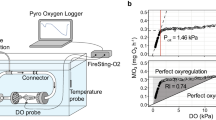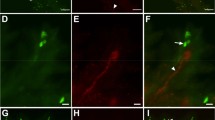Abstract
Neuroepithelial cells (NECs) within the fish gill contain the monoamine neurochemical serotonin (5-HT), sense changes in the partial pressure of oxygen (PO2) in the surrounding water and blood, and initiate the cardiovascular and ventilatory responses to hypoxia. The distribution of neuroepithelial cells (NECs) within the gill is known for some fish species but not for the Gulf toadfish, Opsanus beta, a fish that has always been considered hypoxia tolerant. Furthermore, whether NEC size, number, or distribution changes after chronic exposure to hypoxia, has never been tested. We hypothesize that toadfish NECs will respond to hypoxia with an increase in NEC size, number, and a change in distribution. Juvenile toadfish (N = 24) were exposed to either normoxia (21.4 ± 0.0 kPa), mild hypoxia (10.2 ± 0.3 kPa), or severe hypoxia (3.1 ± 0.2 kPa) for 7 days and NEC size, number, and distribution for each O2 regime were measured. Under normoxic conditions, juvenile toadfish have similar NEC size, number, and distribution as other fish species with NECs along their filaments but not throughout the lamellae. The distribution of NECs did not change with hypoxia exposure. Mild hypoxia exposure had no effect on NEC size or number, but fish exposed to severe hypoxia had a higher NEC density (# per mm filament) compared to mild hypoxia-exposed fish. Fish exposed to severe hypoxia also had longer gill filament lengths that could not be explained by body weight. These results point to signs of phenotypic plasticity in these juvenile, lab-bred fish with no previous exposure to hypoxia and a strategy to deal with hypoxia exposure that differs in toadfish compared to other fish.





Similar content being viewed by others
References
Amador MHB, McDonald MD (2022) Is serotonin uptake by peripheral tissues sensitive to hypoxia exposure? Fish Physiol Biochem 48:617–630. https://doi.org/10.1007/s10695-022-01083-3
Amador MHB, Schauer KL, McDonald MD (2018) Does fluoxetine exposure affect hypoxia tolerance in the Gulf toadfish, Opsanus beta? Aquat Toxicol 199:55–64. https://doi.org/10.1016/j.aquatox.2018.03.023
Borowiec BG, Darcy KL, Gillette DM, Scott GR (2015) Distinct physiological strategies are used to cope with constant hypoxia and intermittent hypoxia in killifish (Fundulus heteroclitus). J Exp Biol 218:1198–1211. https://doi.org/10.1242/jeb.114579
Briceño HO, Boyer JN, Harlem P (2011) Ecological impacts on Biscayne Bay and Biscayne National Park from proposed South Miami-Dade County development, and derivation of numeric nutrient criteria for South Florida estuaries and coastal waters. NPS TA# J5297-08-0085, Florida International University, Southeast Environmental Research Center Contribution # T530, 145.
Cartolano MC, Tullis-Joyce P, Kubicki K, McDonald MD (2019) Do Gulf toadfish use pulsatile urea excretion to chemically communicate reproductive status? Physiol Biochem Zool 92(2):125–139. https://doi.org/10.1086/701497
Coccimiglio ML, Jonz MG (2012) Serotonergic neuroepithelial cells of the skin in developing zebrafish: morphology, innervation and oxygen-sensitive properties. J Exp Biol 215(22):3881–3894. https://doi.org/10.1242/jeb.074575
Coolidge EH, Ciuhandu CS, Milsom WK (2008) A comparative analysis of putative oxygen-sensing cells in the fish gill. J Exp Biol 211(8):1231–1242. https://doi.org/10.1242/jeb.015248
Cordeiro BD, Bertoncini AA, Abrunhosa FE, Corona LS, Araujo FG, Santos LN (2020) First report of the non-native gulf toadfish Opsanus beta (Goode & Bean, 1880) on the coast of Rio De Janeiro-Brazil. BioInvasions Records 9(2):279–286. https://doi.org/10.3391/bir.2020.9.2.13
Dean BW, Rashid TJ, Jonz MG (2016) Mitogenic action of hypoxia upon cutaneous neuroepithelial cells in developing zebrafish. Dev Neurobiol 77(6):789–801. https://doi.org/10.1002/dneu.22471
Dunel-Erb S, Bailly Y, Laurent P (1982) Neuroepithelial cells in fish gill primary lamellae. J Appl Physiol 53:1342–1353. https://doi.org/10.1152/jappl.1982.53.6.1342
Frank L, Serafy J, Grosell M (2023) A large aerobic scope and complex regulatory abilities confer hypoxia tolerance in larval toadfish, Opsanus beta, across a wide thermal range. Sci Tot Environ 899:165491. https://doi.org/10.1016/j.scitotenv.2023.165491
Fritsche BYR, Thomas S, Perry SF, Kin C (1992) Effects of serotonin on circulation and respiration in the rainbow trout Oncorhynchus mykiss. J Exp Biol 173(1):59–73. https://doi.org/10.1242/jeb.173.1.59
Hall MO, Durako MJ, Fourqurean JW, Zieman JC (1999) Decadal changes in seagrass distribution and abundance in Florida Bay. Estuaries 22(2B):445–459. https://doi.org/10.2307/1353210
Hockman D, Burns AJ, Schlosser G, Gates KP, Jevans B, Mongera A, Fisher S, Unlu G, Knapick EW, Kaufman CK, Mosimann C, Zon LI, Lancman JJ, Dong PDS, Lickert H, Tucker AS, Baker CVH (2017) Evolution of the hypoxia-sensitive cells involved in amniote respiratory reflexes. eLife 6:e21231. https://doi.org/10.7554/eLife.21231
Hoffman SG, Robertson DR (1983) Foraging and reproduction of two Caribbean reef toadfishes (Batrachoididae). Bull Mar Sci 33(4):919–927
Holeton GF, Randall DJ (1967a) Changes in blood pressure in the rainbow trout during hypoxia. J Exp Biol 46(2):297–305. https://doi.org/10.1242/jeb.46.2.297
Holeton GF, Randall DJ (1967b) The effect of hypoxia upon the partial pressure of gases in the blood and water afferent and efferent to the gills of rainbow trout. J Exp Biol 46(2):317–327. https://doi.org/10.1242/jeb.46.2.317
Hopkins TE, Serafy JE, Walsh PJ (1997) Field studies on the ureogenic gulf toadfish, in a subtropical bay. II. Nitrogen excretion physiology. J Fish Biol 50(6):1271–1284. https://doi.org/10.1111/j.1095-8649.1997.tb01652.x
Huang C-Y, Lin H-C (2016) Different oxygen stresses on the responses of branchial morphology and protein expression in the gills and labyrinth organ in the aquatic air-breathing fish. Trichogaster microlepis Zool Stud 55:27. https://doi.org/10.6620/ZS.2016.55-27
Jonz MG, Nurse CA (2003) Neuroepithelial cells and associated innervation of the zebrafish gill: a confocal immunofluorescence study. J Comp Neurol 461(1):1–17. https://doi.org/10.1002/cne.10680
Jonz MG, Nurse CA (2005) Development of oxygen sensing in the gills of zebrafish. J Exp Biol 208(8):1537–1549. https://doi.org/10.1242/jeb.01564
Jonz MG, Fearon IM, Nurse CA (2004) Neuroepithelial oxygen chemoreceptors of the zebrafish gill. J Physiol 560(3):737–752. https://doi.org/10.1113/jphysiol.2004.069294
Jonz MG, Buck LT, Perry SF, Schwerte T, Zaccone G (2016) Sensing and surviving hypoxia in vertebrates. Ann New York Acad Sci 1365(1):43–58. https://doi.org/10.1111/nyas.12780
Kermorgant M, Lancien F, Mimassi N, le Mével JC (2014) Central ventilatory and cardiovascular actions of serotonin in trout. Respir Physiol Neurobiol 192(1):55–65. https://doi.org/10.1016/j.resp.2013.12.001
Lapointe BE, Clark MW (1992) Nutrient inputs from the watershed and coastal eutrophication in the Florida Keys. Estuaries 15(4):465–476. https://doi.org/10.2307/1352391
Leite CAC, Florindo LH, Kalinin AL, Milsom WK, Rantin FT (2007) Gill chemoreceptors and cardio-respiratory reflexes is the neotropical teleost pacu, Piaractus mesopotamicus. J Comp Physiol A 193(9):1001–1011. https://doi.org/10.1007/s00359-007-0257-3
McDonald MD, Gilmour KM, Barimo JF, Frezza PE, Walsh PJ, Perry SF (2007) Is urea pulsing in toadfish related to environmental O2 or CO2 levels? Comp Biochem Physiol 146A:366–374. https://doi.org/10.1016/j.cbpa.2006.11.003
McDonald MD, Gilmour KM, Walsh PJ, Perry SF (2010) Cardiovascular and respiratory reflexes in the Gulf toadfish, Opsanus beta, during acute hypoxia. Respir Physiol Neurobiol 170(1):59–66. https://doi.org/10.1016/j.resp.2009.12.012
Mucha S, Chapman LJ, Krahe R (2023) Normoxia exposure reduces hemoglobin concentration and gill size in a hypoxiatolerant tropical freshwater fish. Environ Biol Fish 106:1405–1423. https://doi.org/10.1007/s10641-023-01427-9
Nilsson GE, Östlund-Nilsson S (2008) Does size matter for hypoxia tolerance in fish? Biol Rev 83(2):173–189. https://doi.org/10.1111/j.1469-185X.2008.00038.x
Nilsson GE, Renshaw GMC (2004) Hypoxia survival strategies in two fishes: extreme anoxia tolerance in the north European crucian carp and natural hypoxic preconditioning in a coral-reef shark. J Exp Biol 207:3131–3139. https://doi.org/10.1242/jeb.00979
Nilsson GE, Hobbs J-PA, Östlund-Nilsson S, Munday PL (2007) Hypoxia tolerance and air-breathing ability correlate with habitat preference in coral-dwelling fishes. Coral Reefs 26:241–248. https://doi.org/10.1007/s00338-006-0167-9
Pan W, Scott AL, Nurse CA, Jonz MG (2021) Identification of oxygen-sensitive neuroepithelial cells through an endogenous reporter gene in larval and adult transgenic zebrafish. Cell Tissue Res 384:35–47. https://doi.org/10.1007/s00441-020-03307-5
Perry SF, Reid SG (2002) Cardiorespiratory adjustments during hypercarbia in rainbow trout Oncorhynchus mykiss are initiated by external CO2 receptors on the first gill arch. J Exp Biol 205(21):3357–3365. https://doi.org/10.1242/jeb.205.21.3357
Perry SF, Pan YK, Gilmour KM (2023) Insights into the control and consequences of breathing adjustments in fishes - from larvae to adults. Front Physiol 14:1065573. https://doi.org/10.3389/fphys.2023.1065573
Petersen JK, Pihl L (1995) Responses to hypoxia of plaice, Pleuronectes platessa, and dab, Limanda limanda, in the south-east Kattegat: distribution and growth. Environ Biol Fish 43:311–321. https://doi.org/10.1007/BF00005864
Pichavant K, Person-Le Ruyet J, Le Bayon N, Sévère A, Le Roux A, Quéméner L, Maxime V, Nonnotte G, Boeuf G (2000) Effects of hypoxia on growth and metabolism of juvenile turbot. Aquaculture 188:103–114. https://doi.org/10.1016/S0044-8486(00)00316-1
Porteus CS, Brink DL, Milsom WK (2012) Neurotransmitter profiles in fish gills: putative gill oxygen chemoreceptors. Resp Physiol Neurobiol 184(3):316–325. https://doi.org/10.1016/j.resp.2012.06.019
Randall DJ (1982) The control of respiration and circulation in fish during exercise and hypoxia. J Exp Biol 100(1):275–288. https://doi.org/10.1242/jeb.100.1.275
Randall DJ, Smith LS, Brett JR (1965) Dorsal aortic blood pressures recorded from rainbow trout (Salmo gairdneri). Can J Zool 43(5):863–872. https://doi.org/10.1139/z65-087
Rees BB, Matute LA (2018) Repeatable interindividual variation in hypoxia tolerance in the Gulf killifish. Fundulus grandis Physiol Biochem Zool 91(5):1046–1056. https://doi.org/10.1086/699596
Regan KS, Jonz MG, Wright PA (2011) Neuroepithelial cells and the hypoxia emersion response in the amphibious fish Kryptolebias Marmoratus. J Exp Biol 214(15):2560–2568. https://doi.org/10.1242/jeb.056333
Saltys HA, Jonz MG, Nurse CA (2006) Comparative study of gill neuroepithelial cells and their innervation in teleosts and Xenopus tadpoles. Cell Tissue Res 323(1):1–10. https://doi.org/10.1007/s00441-005-0048-5
Sebastiani J, Sabatelli A, McDonald MD (2022) Mild hypoxia exposure impacts peripheral serotonin uptake and degradation in Gulf toadfish, Opsanus beta. J Exp Biol 225(13). https://doi.org/10.1242/jeb.244064
Serafy JE, Hopkins TE, Walsh PJ (1997) Field studies on the ureogenic gulf toadfish in a subtropical bay. I. patterns of abundance, size composition and growth. J Fish Biol 50:1258–1270. https://doi.org/10.1111/j.1095-8649.1997.tb01651.x
Shelton G, Jones DR, Milsom WK (1986) Control of breathing in ectothermic vertebrates. In: Cherniak NS, Widdicombe JG (eds) Handbook of Physiology, Sect. 3. The Respiratory System, vol 2. Control of Breathing. American Physiological Society, Bethesda, pp 857–909. In
Sundin L, Davison W, Forster M, and Axelsson, M. (1998) A role of 5-HT2 receptors in the gill vasculature of the Antarctic fish Pagothenia borchgrevinki. J Exp Biol 201:3129–2138
Tzaneva V, Perry SF (2010) The control of breathing in goldfish (Carassius auratus) experiencing thermally induced gill remodeling. J Exp Biol 213(21):3666–3675. https://doi.org/10.1242/jeb.047431
Tzaneva V, Gilmour KM, Perry SF (2011) Respiratory responses to hypoxia or hypercapnia in goldfish (Carassius auratus) experiencing gill remodeling. Respir Physiol Neurobiol 175(1):112–120. https://doi.org/10.1016/j.resp.2010.09.018
Ultsch GR, Jackson DC, Moalli R (1981) Metabolic oxygen conformity among lower vertebrates: the toadfish revisited. J Comp Physiol 142(4):439–443. https://doi.org/10.1007/BF00688973
Urbina MA, Glover CN (2012) Should I stay or should I go? Physiological, metabolic and biochemical consequences of voluntary emersion upon aquatic hypoxia in the scaleless fish Galaxias maculatus. J Comp Physiol B 182:1057–1067. https://doi.org/10.1007/s00360-012-0678-3
Vulesevic B, McNeill B, Perry SF (2006) Chemoreceptor plasticity and respiratory acclimation in the zebrafish Danio rerio. J Exp Biol 209(7):1261–1273. https://doi.org/10.1242/jeb.02058
Yokoyama T, Nakamuta N, Kusakabe T, Yamamoto Y (2015) Serotonin-mediated modulation of hypoxia-induced intracellular calcium responses in glomus cells isolated from rat carotid body. Neurosci Lett 597:149–153. https://doi.org/10.1016/j.neulet.2015.04.044
Zhang L, Nurse CA, Jonz MG, Wood CM (2011) Ammonia sensing by neuroepithelial cells and ventilatory responses to ammonia in rainbow trout. J Exp Biol 214:2678–2689. https://doi.org/10.1242/jeb.055541
Acknowledgements
We thank Dr. Michael Schmale for the use of his fluorescent microscope. This work was funded by a National Science Foundation grant (IOS − 1754550) to MDM.
Author information
Authors and Affiliations
Corresponding author
Additional information
Communicated by Bernd Pelster.
Publisher’s Note
Springer Nature remains neutral with regard to jurisdictional claims in published maps and institutional affiliations.
Electronic supplementary material
Below is the link to the electronic supplementary material.
Rights and permissions
Springer Nature or its licensor (e.g. a society or other partner) holds exclusive rights to this article under a publishing agreement with the author(s) or other rightsholder(s); author self-archiving of the accepted manuscript version of this article is solely governed by the terms of such publishing agreement and applicable law.
About this article
Cite this article
Duh, O.A., McDonald, M.D. Gulf toadfish (Opsanus beta) gill neuroepithelial cells in response to hypoxia exposure. J Comp Physiol B (2024). https://doi.org/10.1007/s00360-024-01547-3
Received:
Revised:
Accepted:
Published:
DOI: https://doi.org/10.1007/s00360-024-01547-3




